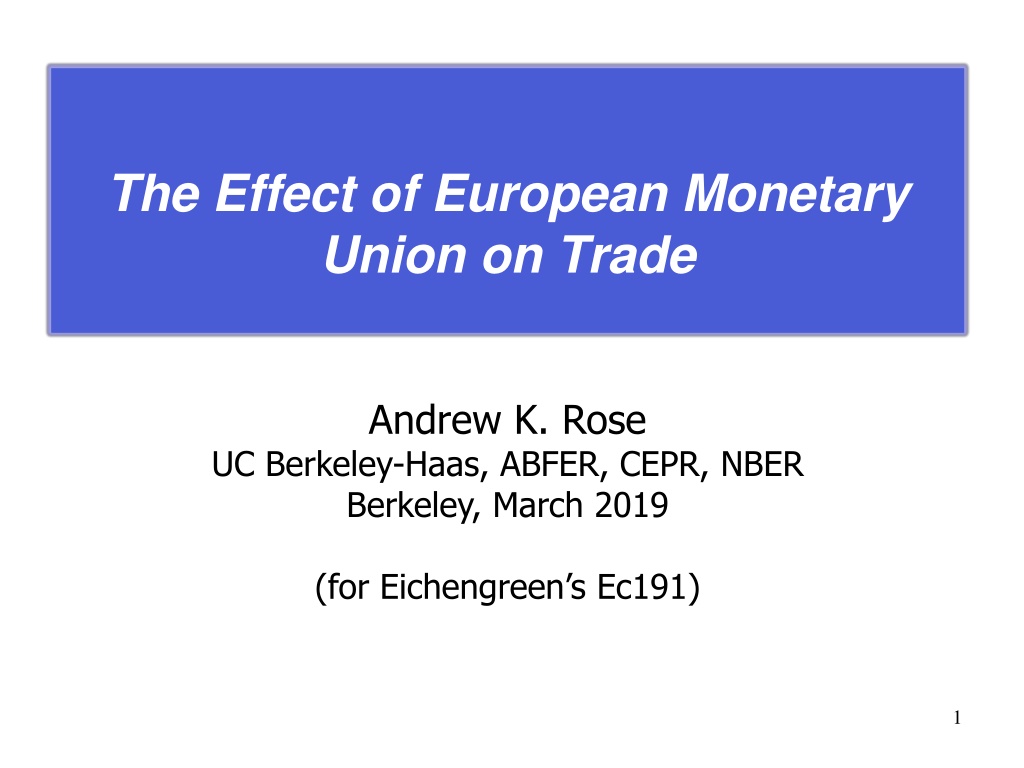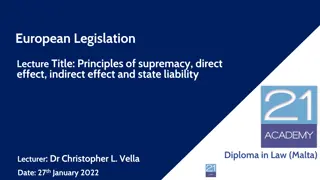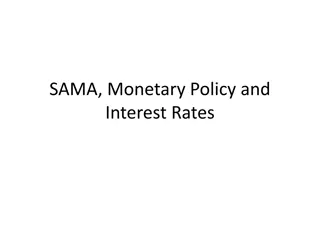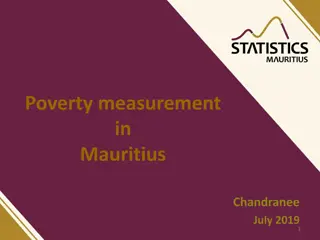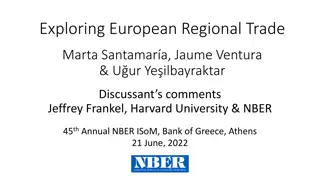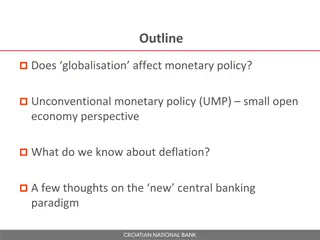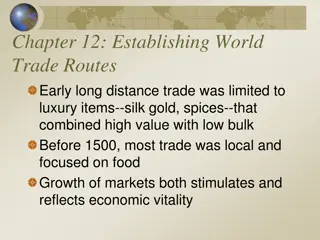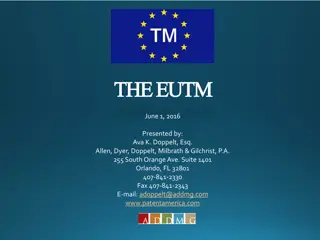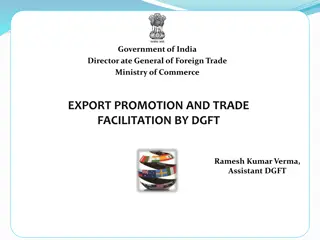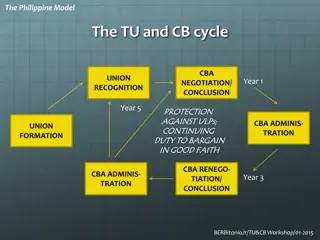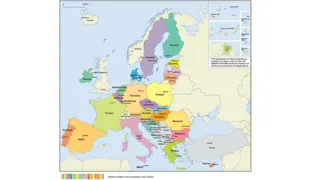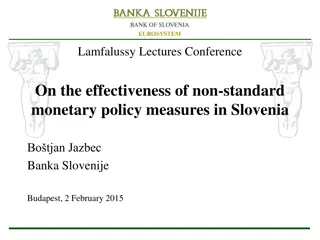The Effect of European Monetary Union on Trade Analysis
Analyzing the impact of European Monetary Union on trade, exploring various aspects such as costs, benefits, literature debates, specific motivations, and preview of findings. Measuring trade effects using the Gravity Equation methodology.
Download Presentation

Please find below an Image/Link to download the presentation.
The content on the website is provided AS IS for your information and personal use only. It may not be sold, licensed, or shared on other websites without obtaining consent from the author.If you encounter any issues during the download, it is possible that the publisher has removed the file from their server.
You are allowed to download the files provided on this website for personal or commercial use, subject to the condition that they are used lawfully. All files are the property of their respective owners.
The content on the website is provided AS IS for your information and personal use only. It may not be sold, licensed, or shared on other websites without obtaining consent from the author.
E N D
Presentation Transcript
The Effect of European Monetary Union on Trade Andrew K. Rose UC Berkeley-Haas, ABFER, CEPR, NBER Berkeley, March 2019 (for Eichengreen s Ec191) 1
Currency Unions Bilateral Currency Unions ( Dollarization ) British : Bahamas (-1965), NZ (-1966), India (-1966), Ireland (-1978) . US $: Panama, Bahamas (1966-), Ecuador (2000-), El Salvador (2001-), Zimbabwe (2009-) . Fr Franc: Morocco (-1957), Algeria (-1968) Multilateral Currency Unions CFA Franc Zones Eastern Caribbean Currency Union Common (Rand) Monetary Area European Economic and Monetary Union, EMU (1999-) 2
Costs and Benefits of Joining a Monetary Union Key Costs Loss of nominal exchange rate as policy tool Loss of national monetary policy control EMU: these costs are high! Potential (Economic) Benefits Greater transparency of prices encourages greater competition and efficiency Reduced currency risk encourages more trade and investment Is there actually any substantive benefit in the data? 3
Debate in Literature on Magnitude of Trade Effect of CUs Big, 90-100%. e.g. Glick and Rose (2002), Frankel (2010) Moderate, 40-50% e.g. Eicher and Henn (2011) Small, 0-20% e.g. Micco et al (2003), Bun and Klaasen (2002, 2007), de Nardis and Vicarelli (2003), Flam and Nordstrom (2007), Berger and Nitsch (2008), Camarero et al (2013) Negative? e.g. Baldwin and Taglioni (2007) 4
Specific Motivation Glick-Rose (2002) used panel approach to investigate effect of currency unions on trade, using data for 1948-1997 before establishment of EMU Found currency unions increase trade by 90% Current paper uses data for 1948-2013 and asks 1. Is EMU similar to other currency unions? 2. Is there symmetry between currency union exit and entry? Assumed symmetry before. Couldn t test because had only 16 entries, 130 exits in 1948-1997 sample Can test now with EMU entries 3. Do advances in methodology matter? 5
Preview of Findings 1. EMU different from other CUs, increases trade among EMU countries by ~50% 2. Find symmetry 3. Econometric methodology matters a lot 4. Sample matters a lot as well 6
Measuring Trade Effects Old Methodology: Gravity Equation ln(Tradeijt) = CUijt + Zijt + { t} + ijt Tradeijt = average nominal value of bilateral trade between i and j at time t, CU = 1 if i and j use the same currency at time t and 0 otherwise, Z = gravity control variables, usual suspects: e.g. GDP, distance, common language, border, regional RTA, colonial history, etc. { t} = year-specific effects 7
Methodological Issues in Estimating Simultaneity (persists) Omitted variables Effects of CU between i and j on other countries through multilateral resistance effects General equilibrium effects on spending and output for all countries Homogeneity implicit in treating all currency unions alike 8
Data Set IMF DoTS trade: >200 countries 1948-2013 (with gaps) Population, real GDP: WDI > PWT > IFS Country Characteristics: World Factbook Regional Trade Agreements (RTAs): WTO Currency Unions: Glick-Rose updated 1:1 par for extended period of time (not just hard fixes) Transitive: x-y and y-z imply x-z 9
Full Results Variable Currency Union Coefficient (se) 1.30 (.13) Variable Number Landlocked Coefficient -.14 (.03) Log Distance -1.11 (.02) Number Islands .05 (.04) Log Product GDP .93 (.01) Log Product Area -.09 (.01) Log Product GDP p/c .46 (.02) Common Colonizer .45 (.07) Common Language .32 (.04) Current Colony .82 (.25) Land Border .43 (.12) Ever Colony 1.31 (.13) Reg l Trade Agree. .99 (.13) Same Nation -.23 (1.05) Observations 219,558 R2 .64 10
Gravity Estimates for Trade EER 2002 Table 1 New With non-EMU and EMU CUs dis-aggregated 1.30 (.13) .92 (.09) All CUs 1.12 (.11) All Non-EMU CUs e1.3 ~3.7x e.92 ~2.5x .02 (.08) All EMU nil 1948-1997 1948-2013 219,558 1948-2013 426,953 Sample period #Obs. 426,953 Note: Pooled OLS estimates. Other gravity regressors and year dummies included, but not reported. Robust standard errors in parentheses. 11
Prefer (Within) Fixed Pair Effect Estimator Exploits variation over time, answers the policy question of interest, i.e. the (time series) question What is the trade effect of a country joining (or leaving) a currency union? Controls for unobserved pair effects, including potential endogeneity of currency union ln(Tradeijt) = CUijt + Zijt + { t} + { ij} + ijt 12
Gravity Estimates for Trade with Pair Fixed Effects EER 2002 Table 2 New With non-EMU and EMU CUs dis-aggregated .65 (.05) .63 (.07) All CUs .75 (.10) All Non-EMU CUs e.41 -1 ~ 51% .41 (.05) 1948-2013 426,953 EMU 1948-1997 219,55 1948-2013 426,953 Sample period #Obs. #Pair FE 11,178 14,801 14,801 13 Note: Pooled OLS estimates. Other gravity regressors and year dummies included, but not reported. Robust standard errors in parentheses.
How Does this Compare with Literature? Easiest to graph (large) literature 14
Forest Plot of (45) Literature EMU Estimates Forest Plot: 45 Estimated EMU Effects Data Data Number of eXport or Dyadic Year-Country % % Starts Ends Countries Trade? FE? FE? ES (95% CI) ES (95% CI) Weight Weight Bun & Klaassen de Souza 2002 2002 1965 1980 2001 2001 17 11 X T 1 0 0 0 0.33 (0.13, 0.53) 0.17 (-0.31, 0.65) 0.33 (0.13, 0.53) 0.17 (-0.31, 0.65) 0.25 (0.18, 0.32) 0.06 (0.01, 0.12) 1.29 0.37 1.29 0.37 2.37 2.46 Barr et al de Nardis & Vicarelli 2003 2003 1978 1980 2002 2000 17 11 T X 0 1 0 0 0.25 (0.18, 0.32) 0.06 (0.01, 0.12) 0.09 (0.01, 0.16) 0.03 (0.00, 0.06) 0.02 (-0.08, 0.12) 2.37 2.46 2.28 2.58 2.09 de Nardis & Vicarelli Baldwin & Taglioni de Sousa & Lochard 2003 2004 2004 1980 1992 1982 2000 2002 2002 32 22 22 X T T 1 1 0 1 0 0 0.09 (0.01, 0.16) 0.03 (0.00, 0.06) 0.02 (-0.08, 0.12) 0.07 (0.01, 0.13) 2.28 2.58 2.09 2.42 Faruqee 2004 1992 2002 22 T 1 0 0.07 (0.01, 0.13) 0.06 (0.04, 0.09) 0.04 (0.01, 0.06) 2.42 2.60 2.60 Maliszewska Micco et al 2004 2004 1992 1992 2002 2002 11 22 T T 1 1 0 0 0.06 (0.04, 0.09) 0.04 (0.01, 0.06) 0.05 (0.04, 0.07) 2.60 2.60 2.63 Aristotelous 2006 1992 2003 20 T 1 0 0.05 (0.04, 0.07) 0.11 (0.07, 0.15) 0.03 (-0.01, 0.06) 0.23 (0.18, 0.28) 2.63 2.54 2.57 2.49 Baldwin & Di Nino Fernandes Flam & Nordstrom 2006 2006 2006a 1994 1988 1995 2003 2003 2005 20 21 20 X X X 1 1 1 0 0 0 0.11 (0.07, 0.15) 0.03 (-0.01, 0.06) 0.23 (0.18, 0.28) 0.14 (0.10, 0.18) 2.54 2.57 2.49 2.54 Flam & Nordstrom 2006b 1989 2002 20 X 1 0 0.14 (0.10, 0.18) -0.11 (-0.17, -0.05) 2.54 2.43 Gomes et al 2006 1980 2003 22 T 1 0 -0.11 (-0.17, -0.05) -0.02 (-0.08, 0.04) 0.03 (0.00, 0.06) 2.43 2.42 2.57 Baldwin & Taglioni Bun & Klaassen 2007 2007 1980 1967 2004 2002 22 19 X T 1 1 1 0 -0.02 (-0.08, 0.04) 0.03 (0.00, 0.06) 0.14 (0.07, 0.20) 2.42 2.57 2.36 Flam & Nordstrom 2007 1995 2005 20 X 1 0 0.14 (0.07, 0.20) 0.22 (0.15, 0.29) 0.07 (0.01, 0.13) 2.36 2.36 2.42 Serlenga & Shin Belke & Spies 2007 2008 1960 1991 2001 2004 14 20 T X 1 1 0 1 0.22 (0.15, 0.29) 0.07 (0.01, 0.13) 0.07 (-0.02, 0.16) 0.07 (0.02, 0.12) 2.36 2.42 2.16 2.47 Berger & Nitsch Brouwer et al 2008 2008 1948 1990 2003 2004 22 29 T X 1 1 0 0 0.07 (-0.02, 0.16) 0.07 (0.02, 0.12) 0.09 (0.03, 0.15) 0.04 (0.01, 0.07) 2.16 2.47 2.42 2.60 Chintrakarn de Nardis et al 2008 2008 1994 1988 2002 2004 22 23 T X 1 0 0 0 0.09 (0.03, 0.15) 0.04 (0.01, 0.07) 0.54 (0.46, 0.62) 2.42 2.60 2.26 Gil-Pareja et al 2008 1950 2004 25 X 1 0 0.54 (0.46, 0.62) 0.12 (0.03, 0.21) 0.93 (0.70, 1.16) 0.17 (0.08, 0.25) 2.26 2.18 1.09 2.18 Angkinand et al Frankel Gomez-Herrera et al 2009 2010 2010 1990 1948 1967 2005 2006 2009 63 217 80 X T X 1 1 1 0 0 0 0.12 (0.03, 0.21) 0.93 (0.70, 1.16) 0.17 (0.08, 0.25) -0.01 (-0.22, 0.21) 2.18 1.09 2.18 1.20 Santos Silva & Tenreyro 2010 1993 2007 17 T 0 1 -0.01 (-0.22, 0.21) 0.16 (0.13, 0.19) 0.04 (-0.00, 0.09) 0.11 (-0.01, 0.23) 1.20 2.58 2.50 1.88 Cafiso Kelejian et al Bergin & Lin 2011 2011 2012 1993 1989 1973 2003 2006 2004 24 17 15 X X X 1 1 0 0 0 1 0.16 (0.13, 0.19) 0.04 (-0.00, 0.09) 0.11 (-0.01, 0.23) 0.19 (0.05, 0.33) -0.08 (-0.13, -0.02) 0.15 (0.13, 0.17) 0.03 (0.00, 0.06) 2.58 2.50 1.88 1.74 2.44 2.60 2.59 Cieslik et al Tykkylainen Camarero et al Serlenga & Shin 2012 2012 2013 2013 1993 1995 1967 1960 2008 2010 2008 2008 48 29 11 14 X T X T 1 1 0 1 0 0 0 0 0.19 (0.05, 0.33) -0.08 (-0.13, -0.02) 0.15 (0.13, 0.17) 0.03 (0.00, 0.06) 0.17 (0.02, 0.32) 1.74 2.44 2.60 2.59 1.64 Camarero et al 2014 1967 2008 26 X 1 0 0.17 (0.02, 0.32) 0.00 (-0.07, 0.07) 0.65 (0.51, 0.79) 0.07 (0.03, 0.11) 1.64 2.33 1.74 2.56 Rotili Sadeh Gunnella et al 2014 2014 2015 1995 1991 1960 2009 2011 2008 40 22 14 X X T 1 1 0 1 1 0 0.00 (-0.07, 0.07) 0.65 (0.51, 0.79) 0.07 (0.03, 0.11) -0.09 (-0.17, -0.01) -0.17 (-0.36, 0.02) 0.43 (0.39, 0.47) 2.33 1.74 2.56 2.25 1.36 2.54 Nahle Figueiredo et al Glick & Rose 2015 2016 2016 1996 1993 1948 2012 2007 2013 18 17 211 X X X 0 1 1 0 1 1 -0.09 (-0.17, -0.01) -0.17 (-0.36, 0.02) 0.43 (0.39, 0.47) 2.25 1.36 2.54 Kunroo et al 2016 1994 2011 29 X 0 0 0.12 (0.05, 0.20) 0.12 (0.05, 0.20) 2.31 2.31 Overall (I-squared = 95.0%, p = 0.000) 0.12 (0.08, 0.15) 0.12 (0.08, 0.15) 100.00 100.00 NOTE: Weights are from random effects analysis -.25 0 0 .25 .5 .75 1 15
Meta-Estimate Random effects estimator delivers estimate of (exp(.116)-1 ) 12.3% Economically non-trivial Statistically significant Robust to reasonable sub-samples 16
Meta-Estimates of EMU Trade/Export Effect Estimator Sample Point Est. 95% Confidence Interval Lower P-value, no Hetero. Upper Fixed All (45) .085 .078 .091 .000 Random All (45) .116 .084 .147 .000 Random Export (27) .140 .092 .189 .000 Random Dyadic (35) .126 .088 .164 .000 Random Monadic (9) .132 -.027 .291 .000 17
Publication Bias Over twenty (of 45) papers unpublished Still, can investigate easily with standard techniques Funnel plots of estimate against precision indicates weak right skew Many estimates outside 95% confidence interval! Results in Figure 2 Conclude: little evidence of publication bias But worrying dispersion! 18
Publication Bias Funnel Plots with Egger Bias Tests Effect of EMU on Bilateral Trade/Exports, differing fixed effects All (45) Estimates Trade (18 estimates) Exports (27) P(bias)=.12 P(bias)=.29 P(bias)=.63 0 0 0 .05 .05 .05 Std. Err. .1 .1 .1 .15 .15 .15 .2 .2 .2 .25 .25 .25 -.5 0 .5 1 -.5 0 .5 1 -.5 0 .5 1 Dyadic (35) Time*Country (9) Dyadic, Time*Country (7) P(bias)=.07 P(bias)=.36 P(bias)=.45 0 0 0 .05 .05 .05 Std. Err. .1 .1 .1 .15 .15 .15 -.5 0 .5 1 -.5 0 .5 1 -.5 0 .5 1 Effect Effect Effect 19
Why do EMU Estimates Vary Across Studies? Rising with (log) observations Small (positive) effect of years in EMU Positive (big) effect of span in years Positive (big) effect of number countries Histograms, scatterplots, regressions all provided in Figure 3 Note paucity of observations Special note: usually very few countries in sample 20
EMU Effect and Sample Size Sample Size and the Estimated EMU Trade Effect 10 10 1 1 8 8 Frequency .5 Frequency .5 Gamma Gamma 6 6 4 4 0 0 2 2 -.5 -.5 0 0 6 8 Log # observations 10 12 14 0 5 Years in EMU 10 15 20 8 1 1 15 6 Frequency .5 Frequency .5 Gamma Gamma 10 4 0 0 2 5 -.5 -.5 0 0 0 20 40 60 0 50 Number of Countries 100 150 200 Data Span in Years 21
Confirmation via Meta-Regression Want to check ocular evidence Strong positive effect of #countries Strong positive effect of #years Other effects? Check via Meta Regression Analysis Check for sensitivity to weighting Check for other determinants 22
Meta Regressions of EMU Trade Effect Obs-1 GSCites-1 Weight Std. Err. Std. Err. Std. Err. Std. Err. Log Countries Log Years Log Obs Time-Vary Country FE Exports not Trade Dyadic FE P(value) .16 (.06) .14 (.05) -.05 (.04) -.03 (.06) .07 (.06) .03 (.06) .63 .15 (.05) .13 (.05) -.03 (.03) -.04 (.07) .04 (.06) .02 (.06) .81 .20 (.05) .09 (.05) .01 (.04) -.07 (.07) .05 (.06) -.01 (.07) .78 .15 (.06) .11 (.05) -.03 (.03) .11 (.04) .09 (.04) -.00 (.07) .05 (.06) .05 (.07) Adjust R2 .26 .27 .47 .27 .29 -.04 23
Quick Summary In literature: longer, wider spans of data over both time and countries systematically associated with higher estimate of EMU trade effect Curious extra data increases even if extra observations not directly relevant to EMU! (Explains why these observations e.g., small/poor countries often omitted from studies; natural to include only relevant observations when estimating EMU trade effect encompassing) 24
Caveat But only 7 papers in literature use preferred methodology (exports, dyadic and time-varying country fixed effects) and most papers use few countries (median 22), years (median 20) So, seems wise to check meta-results with actual data, plain-vanilla methodology 25
Whats Trustworthy? Measuring Trade Effects Newer (Export) Gravity Models Much work on theory-consistent gravity estimation Use Least Squares with time-varying country Dummy Variables (LSDV) (+ dyadic FE) to control for multilateral resistance, other general equilibrium effects: ln(Exportsijt) = CUijt + Zijt+ { it} + { jt} + { ij} + ijt Xijt = nominal bilateral exports from i to j at time t, { it} = set of time-varying exporter dummy variables, { jt} = set of time-varying importer dummy variables { ij} = set of time-invariant pair-specific dummy variables 26
Gravity Estimates for Exports with country-year effects for exporter & importer & country pair FE Table 5 Aggregate With non-EMU and EMU CUs dis-aggregated .34 (.02) All CUs All Non-EMU CUs .30 (.03) .43 (.02) 1948-2013 879,794 22,438 33,886 e.43 -1 ~ 54% EMU Sample period #Obs. #Country-year effects #Pair FE 1948-2013 879,794 22,438 33,886 27 Note: Other gravity regressors and year dummies included, but not reported. Robust standard errors in parentheses.
Tangent: Allow for Dynamic Effects Add (14) leads and lags around currency union exit/entry i.e. Add k kCUENTRYijt-k + k kCUEXITijt-k to gravity equation Distinguish effects between EMU/non-EMU exit and entries Estimate with pair FE Test for Symmetry (post-entry = - post-exit) Find symmetry holds well 28
Allowing Dynamic Effects, CU exit lowers exports, entry raises exports Figure 2 Effects of Currency Union Transitions on log Exports Gravity coefficients (dyadic, exporter/importer x year FE), +/- 2 standard error band 1484 Exits 352 non-EMU Entries 1.5 1.5 .5 .5 -.5 -.5 -1.5 -1.5 -15 -10 -5 0 5 10 15 -15 -10 -5 Years from Entry 0 5 10 15 Years from Exit 784 Entries 432 EMU Entries 1.5 1.5 .5 .5 -.5 -.5 -1.5 -1.5 -15 -10 -5 Years from Entry 0 5 10 15 -15 -10 -5 Years from Entry 0 5 10 15 29
Symmetry Tests, Exports with country-year and pair FE Table 6 F-stat (p value) After CU Entry = - After CU Exit? .8 (.71) Can t reject Before CU Entry = - Before CU Exit? .8 (.68) Both 1.0 (.49) After non-EMU CU Entry = After EMU Entry? 1.3 (.17) Before non-EMU CU Entry = Before EMU Entry? 1.4 (.16) Both 2.8 (.00) Can t reject After non-EMU CU Exit = - After EMU Entry? .9(.51) Table reports F-test statistic for Ho of identical slopes k k k k for given CU pairs and time periods 30
Sensitivity Analysis of Estimates : Dis-aggregating Other CUs .43** (.02) .43** (.02) EMU .30** (.03) -.10 (.06) Other CUs .58** (.10) CFA Franc 1.64** (.11) ECCU $ .39 (.20) Aussie $ .55** (.03) Brit. .87** (.08) French Franc .52** (.11) Indian Rupee -.05 (.06) US $ Note: Other gravity regressors, country-year and pair dummies included, but not reported. 879,794 annual observations, 1948-2013. 31
Sensitivity Analysis of EMU Estimates: Varying Country and Sample Period for EMU 1948-2013 1995-2013 1948-2005 1985-2005 1995-2005 .43** (.02) .47** (.03) .18** (.03) .18** (.03) .18** (.04) All Countries [879,794] [424,230] [691,074] [386,653] [235,510] .11** (.03) .16** (.03) -.02 (.04) -.01 (.04) -.09* (.04) Upper Income Countries (GDP p/c>$12,736) [75,468] [45,401] [52,103] [35,865] [22,036] -.01 (.02) .04 (.02) -.09** (.03) -.16**(.03) -.07 (.04) Industrial Countries + Present/future EU [73,253] [26,763] [61,939] [27,570] [15,449] -.27** (.02) -.04 (.02) -.31** (.04) -.29**(.03) -.10** (.03) Present/future EU [30,731] [13,337] [25,115] [12,230] [7,721] 32 Note: dependent variable is log exports. Other gravity regressors, country-year and pair dummies included, but not reported. Robust standard errors in parentheses; no. of obs. in brackets.
Dimensionality Effects Adding more years increases ! Adding more countries increases Consistent with meta-regressions! 33
Gravity Estimates of EMU Effect Varying end dates and country samples 2001 .08 (.05) 2003 .12 (.04) 2005 .17 (.03) 2007 .19 (.03) 2009 .25 (.02) 2011 .36 (.02) 2013 .43 (.02) All .00 (.05) -.01 (.04) -.02 (.04) -.04 (.03) .00 (.03) .07 (.03) .11 (.03) Rich EU -.33 (.06) -.36 (.05) -.32 (.04) -.28 (.04) -.26 (.07) -.25 (.03) -.24 (.03) 34
Graphical Estimates of EMU Export Effect EMU Effect on log Exports Point Estimate, +/-2 standard errors .5 .25 All Countries; 34,104 dyads Upper Income; 3,989 dyads 0 -.25 European Union; 796 dyads -.5 2001 Gravity model with exporter/importer-year & dyadic FE, 1948-year noted 2005 2009 2013 35
Conclusions from Meta-Regression-cum- Regression Analysis 1. Throwing away data easily allows one to estimate small/negative EMU export effect 2. Adding years of data in EMU (relevant!) increases EMU export effect 3. Adding countries outside EMU (seemingly irrelevant!) increases EMU export effect 36
Why the Differences? Anderson and van Wincoop (2003, p 176); multilateral trade resistance depends positively on trade barriers with all trading partners Dropping small and/or poor countries (likely to have systematically different trade resistance) leads to biased estimates of multilateral trade resistance; higher multilateral resistance leads to more trade. Downward-biased estimates of multilateral resistance biases down. Multilateral trade resistance is a function of all bilateral trade barriers, so all trade partners should be included 37
Estimates of Multilateral Resistance: Evidence of Bias 2001 2003 2005 2007 2009 2011 2013 All .08 (.05) .12 (.04) .17 (.03) .19 (.03) .25 (.02) .36 (.02) .43 (.02) .00 (.05) -.01 (.04) -.02 (.04) -.04 (.03) .00 (.03) .07 (.03) .11 (.03) Rich -.33 (.06) -.36 (.05) -.32 (.04) -.28 (.04) -.26 (.07) -.25 (.03) -.24 (.03) EU Observations All Rich EU Average of Exporter/Importer-Year Fixed Effects, { it}, { jt} for rich-country Observations Exporter (All) .94 .94 Importer (All) 1.18 1.17 Average of Exporter/Importer-Year Fixed Effects, { it}, { jt} for other non-rich Observations Exporter (All) -.07 -.07 Importer (All) -.09 -.09 Average difference between Full and Rich sample estimates for EMU observations Exporter .65 .64 .64 Importer 1.10 1.06 .99 597,565 42,673 22,887 642,571 46,851 24,341 688,519 51,824 25,788 735,025 57,317 27,350 782,047 62,764 28,891 829,708 68,428 30,434 877,736 75,096 31,982 .94 1.16 .95 1.15 .97 1.14 .98 1.12 1.00 1.10 -.08 -.10 -.08 -.10 -.08 -.10 -.09 -.10 -.09 -.10 .62 .95 .66 .86 .67 .77 .67 .68 38
Summary Glick-Rose (2002) concluded a pair of countries which joined/left a currency union experienced a near-doubling/halving of bilateral trade. Based on: 1. Assumption of symmetry between currency union exits and entries 2. Caveat: EMU might be different from other currency unions 3. Our results insensitive to precise econometric methodology Here, re-estimate using variety of models, annual panel >200 countries, 1948-2013, 15 EMU years 39
Conclusions Methodology and sample matter Preferred methodology is panel with country-pair fixed effects Preferred sample includes all countries, all periods of time Symmetry holds between currency union entry and exits EMU is different EMU boosts trade by 50% Other currency unions have different effects on trade 40
Conclusion/Summary: Why do Estimates of EMU Trade Effect Vary so Much? Varying sample sizes by time and (especially) country More Data is Better! Established via meta-analysis and regressions Truncating sample (omitting small/poor countries) biases downward EMU trade effect in a) theory, b) data, and c) literature Including entire post-war sample of countries/years delivers large estimate of EMU export effect of .43 or (exp(.43-1 ) 54%! Economically large (may grow) Statistically significant (robust t-statistic>20) Quite consistent with Rose-Stanley survey (2005): 47% 41
Future Research Handling zero and missing trade observations LS estimates may be biased because of: 1. Heteroskedasticity, and/or 2. Discarded observations of zero/missing trade Santos Silva and Tenreyro propose Poisson pseudo- maximum likelihood to handle both Used to be difficult in big panels Now Done by Larch, Wanner, Yotov and Zylkin, others Interaction of effects of joining CUs and other forms of economic integration, such as regional trade arrangements Countries joined EU shortly before EMU 42
